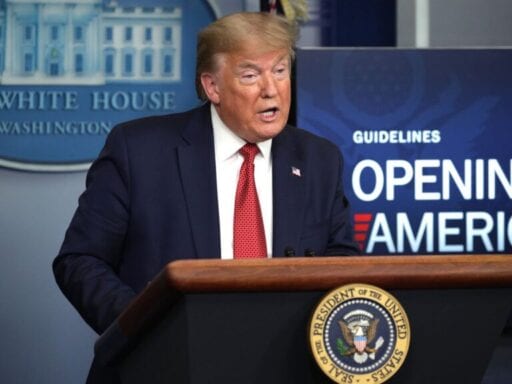We’re nowhere close.
The number of new coronavirus tests reported each day has plateaued — a big blow to the prospects of America reopening its economy safely anytime soon, even as President Donald Trump insists the country is weeks away from doing so.
Trump announced guidelines on April 16 for states to reopen, calling for governors to ease social distancing measures, such as stay-at-home orders, as new coronavirus cases begin to come down. He acknowledged a requirement for reopening the economy is that the federal government and states must know that the numbers of new coronavirus cases are actually coming down; without widespread testing, they simply can’t know what they’re dealing with and how to act.
Trump also claimed testing is “at an all-time high” and “growing at a historic rate.” But that’s false, based on the actual numbers.
According to the Covid Tracking Project, the US has averaged fewer than 150,000 tests each day so far in the week of April 13, including at both public and commercial labs. That’s an improvement from the early days of March, when the country reported new tests in the dozens and later the hundreds. But it’s not an increase from more recent weeks: In the week of April 6, the country also averaged fewer than 150,000 tests a day.
What the country needs to properly do testing, according to experts, is at least 500,000 tests a day. Some experts call for much more than that — millions or even tens of millions a day — but the general point is that the US needs to be doing multiple times the testing that it’s currently doing to be able to test everyone with symptoms and their close contacts.
A recognition of that fact is perhaps the biggest reason the US is social distancing now. One of the big goals during this period is to flatten the curve — reducing the spread of the virus — as the US scales up testing and surveillance systems to let the nation and states better control new clusters of cases.
“The whole point of this social distancing is to buy us time to build up capacity to do the types of public health interventions we know work,” Natalie Dean, a biostatistics professor at the University of Florida, told me. “If we’re not using this time to scale up testing to the level that we need it to be … we don’t have an exit strategy. And then when we lift things, we’re no better equipped than we were before.”
Testing gives officials the means to isolate sick people, track and quarantine the people whom those verified to be sick came into close contact with (a.k.a. “contact tracing”), and deploy community-wide efforts if a new cluster of cases is too large and uncontrolled otherwise. Without it, the only way to deal with the outbreak is more social distancing, which further hurts the economy, or letting the disease run its course — at the cost of potentially hundreds of thousands or millions of lives.
The recent slowdown in new tests is driven by shortages in nasal swabs, personal protective equipment, reagents, test kits, and machines needed to run the specific tests required. According to David Lim at Politico, some labs also complain that the Centers for Disease Control and Prevention’s testing criteria — which prioritizes hospitalized patients, health care workers, and those vulnerable to the virus, such as older people — is holding back potential tests, leaving existing testing capacity unused.
To fix the gaps, experts argue, the federal government needs to relax criteria for testing, invest in new supplies and labs, and better coordinate supply chains to address, among other issues, chokepoints. States, with limited resources and little control of the national supply chain, simply can’t do this all on their own.
Such fixes, however, are easier said than done. Experts warn the next phase of testing will be much more difficult than the initial phase, which largely required getting existing labs to start doing coronavirus testing — the low-hanging fruit.
“We’ve made substantial progress ramping testing this month,” Scott Gottlieb, a former commissioner of the Food and Drug Administration, wrote in a tweet on April 10. “But many gains were made by getting players into fight (clinical labs, academic labs). Now we must expand lab capacity, platforms, throughput, test kits. Getting next million tests/week will be harder than getting first.”
This is one reason the plans to end social distancing are so grim: Not only do they suggest that some level of social distancing will be needed for the next year or so (until a vaccine or a similarly effective treatment is widely available) — which we don’t know if the country can sustain — but they call for a level of surveillance and testing the US simply hasn’t shown the ability and willingness to build and manage yet.
It’s possible the US could get a lucky break; there’s still a lot about the coronavirus that we don’t know, and maybe as we learn more, we’ll realize the country can be spared the worst. (That’s optimistic, given the outbreaks we’ve already seen across the globe, but it’s possible.) The Trump administration and states also still have time to ease testing criteria and scale up capacity in the coming weeks.
But unless something changes, America is simply not meeting the benchmark of aggressive testing that experts say is necessary to start to reopen the country. As eager as Trump is to get the economy going again, the US just isn’t ready to do it in a safe way yet.
Author: German Lopez
Read More



